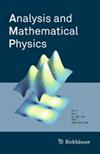Boundedness of solutions of Chern-Simons-Higgs systems involving the \(\Delta _{\lambda }\)-Laplacian
IF 1.4
3区 数学
Q1 MATHEMATICS
引用次数: 0
Abstract
The purpose of this paper is to study the boundedness of solutions of the Chern-Simons-Higgs equation
$$\begin{aligned} \partial _tw-\Delta _{\lambda } w = \left| w \right| ^2 \left( \beta ^2-\left| w \right| ^2\right) w-\frac{1}{2}\left( \beta ^2-\left| w \right| ^2 \right) ^2w \text{ in } \mathbb {R}\times \mathbb {R}^N \end{aligned}$$
and system
$$\begin{aligned} {\left\{ \begin{array}{ll} \partial _t u -\Delta _\lambda u = u^2\left( 1-u^2-\gamma v^2\right) u-\frac{1}{2}\left( 1-u^2-\gamma v^2 \right) ^2u & \text { in } \mathbb {R}\times \mathbb {R}^N, \\ \partial _t v -\Delta _\lambda v = v^2\left( 1-v^2-\gamma u^2\right) v-\frac{1}{2}\left( 1-v^2-\gamma u^2 \right) ^2v & \text { in }\mathbb {R}\times \mathbb {R}^N,\\ \end{array}\right. } \end{aligned}$$
where \(\gamma >0\), \(\beta \) is a bounded continuous function and \(\Delta _{\lambda }\) is the strongly degenerate operator defined by
$$\begin{aligned} \Delta _{\lambda }:=\sum _{i=1}^N \partial _{x_i}\left( \lambda _i^2\partial _{x_i} \right) . \end{aligned}$$
Under some general hypotheses of \(\lambda _i\), we shall establish some boundedness properties of solutions of the equation and system above. Our result can be seen as an extension of that in [Li, Yayun; Lei, Yutian, Boundedness for solutions of equations of the Chern-Simons-Higgs type. Appl. Math. Lett.88(2019), 8-12.]. In addition, we provide a simple proof of the boundedness of solutions.
涉及\(\Delta _{\lambda }\) -拉普拉斯算子的chen - simons - higgs系统解的有界性
本文的目的是研究Chern-Simons-Higgs方程$$\begin{aligned} \partial _tw-\Delta _{\lambda } w = \left| w \right| ^2 \left( \beta ^2-\left| w \right| ^2\right) w-\frac{1}{2}\left( \beta ^2-\left| w \right| ^2 \right) ^2w \text{ in } \mathbb {R}\times \mathbb {R}^N \end{aligned}$$和系统$$\begin{aligned} {\left\{ \begin{array}{ll} \partial _t u -\Delta _\lambda u = u^2\left( 1-u^2-\gamma v^2\right) u-\frac{1}{2}\left( 1-u^2-\gamma v^2 \right) ^2u & \text { in } \mathbb {R}\times \mathbb {R}^N, \\ \partial _t v -\Delta _\lambda v = v^2\left( 1-v^2-\gamma u^2\right) v-\frac{1}{2}\left( 1-v^2-\gamma u^2 \right) ^2v & \text { in }\mathbb {R}\times \mathbb {R}^N,\\ \end{array}\right. } \end{aligned}$$的解的有界性,其中\(\gamma >0\), \(\beta \)是有界连续函数,\(\Delta _{\lambda }\)是$$\begin{aligned} \Delta _{\lambda }:=\sum _{i=1}^N \partial _{x_i}\left( \lambda _i^2\partial _{x_i} \right) . \end{aligned}$$定义的强退化算子,在\(\lambda _i\)的一些一般假设下,我们建立了上述方程和系统解的一些有界性性质。我们的结果可以看作是[Li, Yayun];雷玉田,chen - simons - higgs型方程解的有界性。苹果。数学。通讯,2019,(3):8-12。此外,我们还提供了解的有界性的一个简单证明。
本文章由计算机程序翻译,如有差异,请以英文原文为准。
求助全文
约1分钟内获得全文
求助全文
来源期刊

Analysis and Mathematical Physics
MATHEMATICS, APPLIED-MATHEMATICS
CiteScore
2.70
自引率
0.00%
发文量
122
期刊介绍:
Analysis and Mathematical Physics (AMP) publishes current research results as well as selected high-quality survey articles in real, complex, harmonic; and geometric analysis originating and or having applications in mathematical physics. The journal promotes dialog among specialists in these areas.
 求助内容:
求助内容: 应助结果提醒方式:
应助结果提醒方式:


